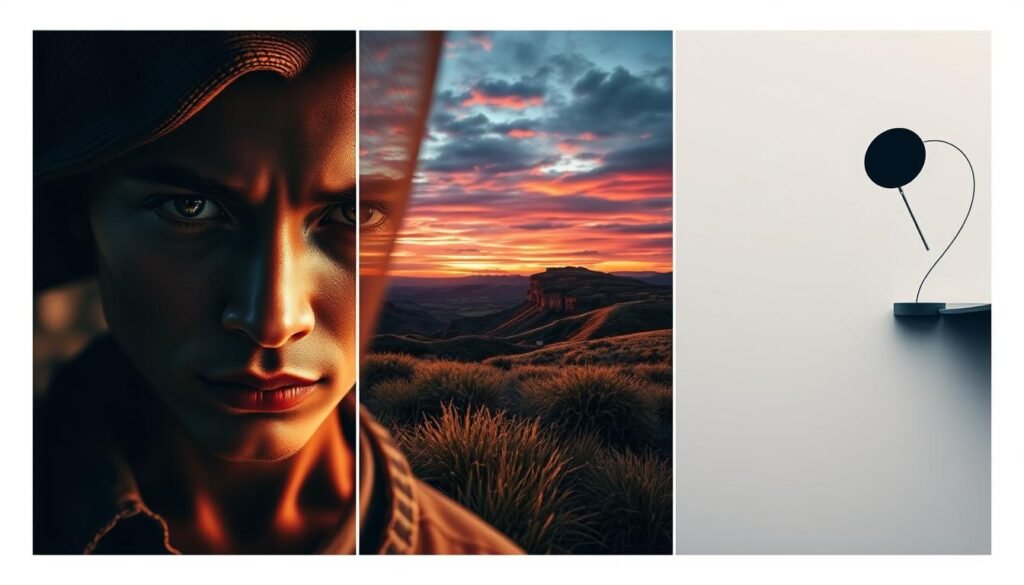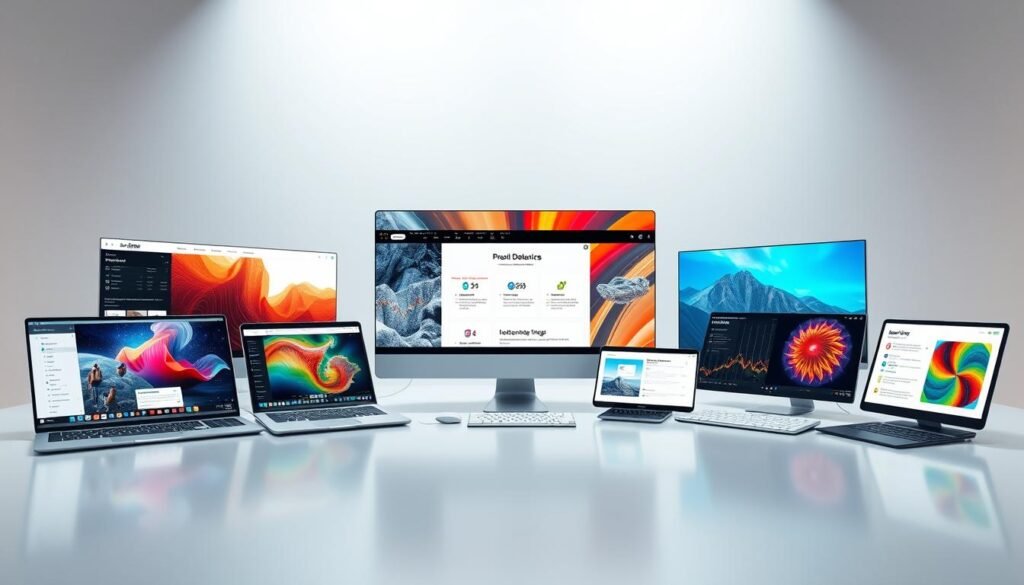Can a single platform truly speed up your content workflow and keep your visuals authentic?
Gramhir Pro AI: Boost Your Social Media
Gramhir Pro AI brings together an image generator, detection, grammar checks, paraphrasing, translation, and plagiarism tools in one place. You get a unified platform to create visuals and validate originality, so publishing moves faster and with more confidence.
The image engine uses GAN-style loops and prompt interpretation to produce high-resolution outputs for web, print, and social media. Generation is fast—simple prompts take seconds, while complex requests remain steady.
You will find built-in support for editing, language checks, and batch processing that help creators and users scale content without juggling apps. Clear controls keep image quality consistent for campaigns and brand needs.
Key Takeaways
- You get an all-in-one platform to create and verify content quickly.
- Fast image generation delivers export-ready visuals for social media.
- Built-in tools reduce the number of apps you must use.
- Batch processing helps creators publish at scale with consistent quality.
- Detection and checks protect authenticity and brand standards.
Overview: Why this Product Review of Gramhir Pro AI matters today
As image generation choices multiply, users must weigh usability against output fidelity.
You face a crowded media and marketing landscape where teams must publish more content with fewer resources. This review cuts through the noise to show what the platform actually delivers for daily workflows.
Gramhir.pro combines live generation, multi-format exports, and integrated writing and detection tools. That mix reduces app switching and speeds up design-to-post cycles for creators and marketers.
The review highlights clear benefits: time savings, fewer steps, and built-in checks that protect originality. It also explains which users gain most—beginners who need a simple interface and professionals who want production-ready outputs.
“You should expect realistic previews, fast exports, and validation tools that reduce rework.”
- Quick sense of real features and day-to-day impact
- How image generation and writing tools lower friction
- Practical expectations for performance, quality, and cost
What is Gramhir Pro AI and how it works
A unified platform combines detection, image generation, and writing helpers so you can create and verify content in one workflow.
GramhirPro AI Detector: advanced AI content detection and reporting
The detector scans text and images to find patterns that suggest machine generation. It produces clear reports you can review before publishing.
Key features include source probability scores, region-level image flags, and a user-friendly report viewer that helps you decide next steps.
“Reports from the detector help you minimize risk from questionable sources and maintain trust with your audience.”
AI image, photo, and picture generators: from text to high-quality visuals
Under the hood, GAN-based algorithms work with language models to interpret prompts and keep style consistent across outputs. You control color, lighting, texture, composition, and templates.
The image generator supports high-resolution exports for web, print, social, and e-commerce. Live preview and multi-image batching speed iteration for designers and users.
Writing helpers: grammar checker, paraphraser, and translator for clean, original content
Built-in writing tools cover grammar checking, paraphrasing, translation, and plagiarism checks. Together, they keep your content clear and original.
- You can verify ai-generated images and text with integrated checks and detailed authenticity reports.
- The single tool links creation and compliance, reducing rework and improving turnaround.
- Interfaces are simple for new users, yet deep enough for advanced design and publishing needs.
Key features that set the platform apart for creators and marketers
A single workflow that ties image creation to verification keeps campaigns on schedule.
Image generation and export
High-resolution images and multiple styles let you match campaign needs quickly.
You see live previews and pick formats for web, print, or social. This reduces back-and-forth with designers.
Accurate detection and reporting
The detector flags likely machine-generated text and images and creates clear reports. You use these reports to approve or revise content before publishing.
Writing tools for clarity and originality
Built-in grammar checks and paraphrasing help you keep tone and brand style consistent. Plagiarism reports add another layer of quality control.
Context-aware translation
Translation covers a wide range of languages and keeps nuance intact. That lets you adapt content for global audiences without losing meaning.
“You can enforce standards across images and text, so your campaigns ship faster and with fewer revisions.”
| Feature | What it gives you | Best for |
|---|---|---|
| Live previews | Instant feedback on composition and color | Social posts, ads |
| Detection reports | Clear authenticity scores and flags | Compliance, brand trust |
| Writing suite | Grammar, paraphrase, translation, plagiarism | Global content, editorial teams |
- You move from prompt to polished image with export-ready formats.
- Controls over style, resolution, and formats ensure consistent quality.
- Text and image workflows live together, cutting tool switching and revisions.
Image quality, styles, and control: getting the visuals you need
Strong rendering control lets you dial sharpness, color depth, and contrast for each asset. Tests show crisp edge definition, accurate textures, and smooth gradients that preserve highlights and shadows. This keeps your content ready for feed or print without extra cleanup.
Resolution and fidelity:
Resolution and fidelity
You get high-resolution images that scale from social thumbnails to print posters while retaining fine detail. The platform’s algorithms protect gradient smoothness and color depth when you enlarge or crop.
Style and variety:
Style variety
Choose from digital, surreal, classical, or brand-aligned looks. Templates and style presets help you keep a coherent visual direction across a campaign.
Prompting and parameters:
Prompting and parameters
Adjust lighting, composition, texture, and templates to match placement needs. The process supports iterative edits without quality loss, so your prompts translate into consistent art direction.
- Repeatable quality: Tools and templates give predictable outcomes.
- Multi-format support: Outputs suit web, print, social, and e-commerce with minimal rework.
- Efficient workflow: Visual variety stays high while coherence is preserved across a series.

Performance and user experience in the present day
Today’s benchmarks focus on how quickly you can turn a concept into a final image without surprise delays.
The platform delivers predictable speeds you can plan around. Simple images render in about 3–5 seconds. Complex compositions take 6–8 seconds, while highly detailed artwork finishes in 8–12 seconds.
Speed benchmarks and batch performance
Speed matters when deadlines are tight. Batch processing generates multiple assets at once and applies a uniform style across the set.
Automated quality checks and error handling run during batches, so you get consistent output without repeating manual steps.
Consistency for scaled content creation
The process preserves look and feel across dozens of files. That makes it easier to schedule campaigns and keep brand standards.
Stability under load means the platform holds up during peak publishing windows.
Interface and learning curve for different users
The interface balances beginner paths with advanced controls for professionals. New users may see a short learning curve.
As you adopt repeatable settings, productivity usually improves and the day-to-day experience gets faster.
“You can plan timelines around predictable generation speeds by prompt complexity and batch volume.”
- You can rely on consistent image performance from single assets to large series.
- Responsive previews speed iteration and reduce last-minute fixes.
- Automated checks help keep content quality steady while you focus on creative direction.
| Metric | Typical time | Batch features | Best for |
|---|---|---|---|
| Simple prompts | 3–5 sec | Fast parallel generation | Social posts, thumbnails |
| Complex prompts | 6–8 sec | Style lock and QA | Campaign visuals |
| Highly detailed | 8–12 sec | Error handling, retries | Print, high-res art |
| Load stability | Consistent | Maintains throughput | Peak publishing windows |
Integrations, API, and workflow fit
Plugging the platform into your existing stack cuts friction and speeds delivery.
Creative tool connections link design and publishing without extra steps.
Photoshop, Canva, and Figma support
You install an Adobe Photoshop plugin to generate and iterate inside familiar design files.
Exports are Canva- and Figma-friendly so designers can import assets with preserved layers and presets.
CMS and developer options bring generation closer to publish time.
WordPress, Joomla, Drupal, and the API
You can create images directly inside WordPress and other CMSs to speed content creation and management.
Developers get a documented API: create an account, generate a key, follow the docs, implement calls, handle errors, test, and optimize.
“Integrations reduce tool-switching and keep creation centralized.”
- Asset versioning and governance integrate with your file management.
- Security controls protect API keys and meet compliance needs.
- Templates and automation standardize the process across teams.
| Integration | What it enables | Best use |
|---|---|---|
| Photoshop plugin | In-app image generation and iterative edits | Design-heavy workflows |
| Canva / Figma export | Layered imports and style presets | Fast campaign layouts |
| CMS connectors | Direct generation, automated processing | Publishing pipelines |
| Documented API | Custom calls, error handling, optimized throughput | Developer integrations |

Pricing and plans: free, premium, and enterprise support
Costs matter, but the right plan should trade off spend for time saved and higher image quality.
Free vs. premium access: features, limits, and value
Free gives you basic image generation, a few styles, and standard formats so you can test core features. This tier fits single users or creators who produce low volumes.
Premium unlocks all styles, advanced design tools, higher generation limits, and faster exports. It is designed for professionals who need consistent quality and repeatable outputs for campaigns.
Enterprise capabilities: bulk processing, integrations, and priority support
Enterprise plans add bulk processing, advanced integrations, account management, and priority support. Packages scale to a wide range of budgets, with indicative setups starting near £476.50 and extending to £27,795.60+ for large deployments.
“You can right-size your plan as your workload and brand ambitions grow.”
| Tier | Best for | Main benefits |
|---|---|---|
| Free | Individual users | Basic generator, limited styles, standard formats |
| Premium | Professionals | Full tools, higher limits, better quality |
| Enterprise | Teams & agencies | Bulk generation, integrations, priority support |
- You can test on a free plan, then upgrade when your production needs expand.
- Premium helps professionals deliver higher design and image quality at pace.
- Enterprise supports complex management, standardizes outputs, and reduces outsourcing costs.
- Evaluate value by mapping features to your generation volume and team needs.
Who should use gramhir pro ai
Different users want different outcomes—some need quick posts, others require print fidelity.
Beginners and content creators: quick visuals and post-ready assets
If you are one of the beginners, guided prompts and presets speed setup. You can ship post-ready images and posts with minimal tweaking.
Content creators streamline daily output by saving styles and using repeatable settings.
Design and marketing professionals: brand consistency and print-ready quality
Design and marketing professionals get fine control over color, resolution, and layout. That helps you keep brand fidelity and hit print-grade specs.
“The platform balances fast iteration with professional export options.”
Teams and businesses: collaboration, management, and budget efficiency
Teams gain standardized templates, asset pipelines, and integrations. This reduces handoffs and keeps approvals on schedule.
Match plan tiers to your needs—from solo creators to agency-level workflows—to cut production time without cutting quality.

| Role | Primary benefit | Best fit |
|---|---|---|
| Beginners | Guided prompts, quick exports | Social posts, simple campaigns |
| Content creators | Repeatable styles, faster output | Daily publishing |
| Professionals | Print-ready exports, brand control | Marketing, design teams |
| Teams | Collaboration, integrations | Agencies, enterprises |
Pros and cons to consider before you commit
Deciding whether to commit starts with a clear look at what the platform delivers and what it asks of you.
Key benefits include high-resolution output and consistent style, which reduce post-production work and boost content quality. Integrated writing and detection tools help you avoid publishing ai-generated images unintentionally.
Multi-tool integration cuts subscriptions and smooths handoffs for users who manage many assets. The platform supports compliance and brand safety in regulated workflows.
On the flip side, some users face a steeper learning curve than with simpler apps. In a few cases, other services produce images without short delays that you might notice on tight deadlines.
“Run a short pilot to measure quality gains and throughput before you roll the platform wide.”
- You get strong image quality and features that lower rework.
- Detection reports protect against unwanted ai-generated images.
- Plan onboarding: the breadth of tools improves outcomes once users ramp up.
| Pros | Cons | When to pick |
|---|---|---|
| High-resolution images, style consistency | Steeper learning curve for new users | Teams needing consistent quality |
| Multi-format exports and integrated tools | Occasional slower generation vs fastest rivals | Workflows that value control over raw speed |
| AI detection and compliance reports | Onboarding time required for full feature use | Regulated environments and brand teams |
Top Gramhir Pro AI image generator alternatives in 2025
Choosing the right generator depends on whether you value prompt nuance, workflow plugins, or open-source flexibility.
OpenAI DALL·E 3 excels at language understanding and turns complex prompts into detailed images. It suits users who need precise text-to-image mapping and multilingual support.
Adobe Firefly 2.0 offers deep customization and tight Adobe ecosystem integration. Designers get camera, lighting, and style controls that speed campaign-level image generation for marketing teams.
Think Diffusion & Stable Diffusion XL/3.5 give professionals pro-level control with SDXL, ControlNet, inpainting, outpainting, and AnimateDiff. These generators are flexible and open-source friendly.
Midjourney V7 focuses on artistic depth, a vibrant community, and discovery via an explore page and Discord. It’s built for stylized visuals and creative experiments.

Other options include Ideogram 2.0 for accurate text-in-image, Canva AI for end-to-end template design, and budget-friendly picks like Leonard, NightCafe, Craiyon, Freepik AI, and Imagen 2 for professional outputs.
“Your best choice depends on workflow, interface preferences, and the set of features you prioritize.”
| Generator | Strength | Best for |
|---|---|---|
| DALL·E 3 | Advanced language understanding, precise prompts | Detailed concept art, multilingual briefs |
| Adobe Firefly 2.0 | Design controls, Adobe integration | Marketing teams, brand assets |
| SDXL / Think Diffusion | Open-source customization, ControlNet | Professionals needing fine control |
| Midjourney V7 | Artistic styles, community discovery | Creative exploration, stylized campaigns |
Use cases across social media, marketing, and e‑commerce
Creating visuals for different feeds becomes simple when templates and batch exports match each platform.
Gramhir.pro outputs web-ready formats with custom dimensions, high-resolution files for print, and platform-specific ratios for social media. This centralizes image creation and review so you move faster from brief to publish.
Social media publishing: platform-specific sizes and campaign visuals
You can generate assets for posts, stories, and ads with correct aspect ratios for each channel. Batch creation produces multiple variants for A/B tests and seasonal campaigns.
That reduces manual resizing and speeds up post scheduling across networks.
Marketing and branding: cohesive series, ads, and email assets
Marketing teams create consistent series for landing pages, paid ads, and email visuals using repeatable settings. Templates keep brand colors and typography aligned across every image.
Built-in translation and grammar tools help you localize copy without leaving the platform.
E‑commerce and media: product imagery, thumbnails, and concept art
E‑commerce workflows benefit from background-cleared product shots, thumbnails, and high-quality images suitable for catalogs and commerce listings. Media teams turn concepts into production-ready visuals while keeping text on-brand.
- You generate platform-specific assets for social media at scale.
- Batch processing speeds delivery of campaign series and variants.
- Centralized creation reduces management overhead and preserves brand consistency.
“High-quality images and repeatable workflows make it easier to hit publishing schedules and keep creative consistent.”
Conclusion
You can move from concept to campaign faster when tools for image creation and content checks live in one place. This platform helps you produce clear content today with fewer apps and less friction.
From prompt to export, you get predictable image quality, fast generation, and integrated detection and writing tools that clean text before publish. Built-in integrations with design apps and CMSs mean the capabilities you need join common workflows, and support options scale with your plan.
Next step: pilot a workflow, measure time saved, and tune reusable styles. If consistency, speed-to-asset, and compliance matter, this setup can meet your design and delivery needs.



